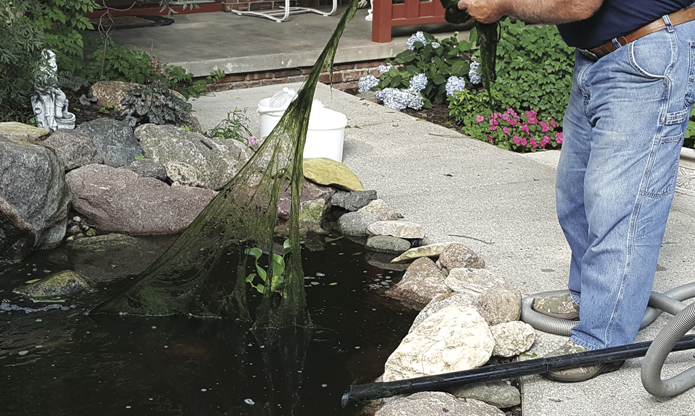
Anyone who has been involved with water gardens for even a short period of time understands how algae can be a curse. When you think about what to do with string algae, such as filamentous algae and blanket weed, or pea-green soup algae, which is the same as planktonic and single-celled algae, it can create nightmares. We all have battled these algae.
But how can algae be a blessing? This is very much the case for some types of algae, which can be critically important for the ecosystem. It is my opinion that the average person should appreciate algae and not necessarily want to scrub it off or kill all of it in their pond’s ecosystem.
The number of algal species is estimated at up to 10 million, with most of them very small, like microalgae. Because of so many species, there are always exceptions to controlling some types. It is all about control — not about killing it.I have simplified the process of explaining algae by arranging the common types into three groups. (There are other very unusual categories of algae, but I will not address those in this article.) The three groups are free-floating, single-celled (planktonic) algae, string algae and surface (biofilm) algae. All three types of these algae need a lot of sunlight and warmth to prosper.
Planktonic Algae
This free-floating form of single-celled algae can show up early in a newly established water garden. Within a few days to a couple of weeks after installation, it may turn into a pea-green soup. This alga is one that tells you that the ecosystem is out of balance. The bacteria that become established in an ecosystem are the major component that controls the single-celled algae. In a newly established water garden, an ecosystem is nonexistent — bacteria are in low numbers, and the organics present in the water feed these algae and help them thrive. Organics include anything that was once alive and is now dead, like fish waste, decaying leaves and uneaten fish food. Bacteria degrade these organics into other components that pea-green soup algae can no longer use for growth.
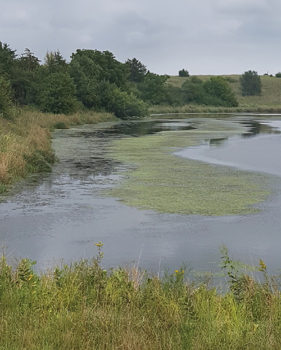
There is a balanced ratio of organic material to bacteria in a mature ecosystem. When organics get very high in relation to the number of bacteria, pea-green soup algae will grow. The extent to which this type of algae will grow depends on the ecosystem’s component of bacteria. These algae may not even be detectable, but they can grow to levels where you can only see about an inch deep into the water.
These algae are everywhere, and they are always present in an ecosystem. Adding bacteria to ponds is always a good idea to degrade the organics. In most situations, this will be enough to control the pea-green soup algae. You can also add UV clarifiers. When these single-celled algae are exposed to UV light, they die, clump up and settle out.
If the water is gin-clear, you know you have good control over single-celled algae. If the water is somewhat cloudy, you may have an issue. Just put some of the pond water in a clear glass jar. Let it sit for several hours or overnight. If it clears with a light sediment layer on the bottom of the jar, you have a sediment issue — not a single-celled algae issue. But if the water has a cloudy, greenish look to it when held up to the light, you probably have an algae-related issue. Sediment can confuse a lot of people into thinking they have an algae problem, when in fact they do not.
String Algae
This type of algae is also known as blanket weed or filamentous algae. It can be a huge problem, not only for us water gardeners but also for anyone who has a body of water with the right nutrients for string algae to prosper. Farm pond and lake owners know this stuff as moss. There are a lot of different kinds of moss, but the most common type looks stringy and contains bubbles entrained in the mats of moss.
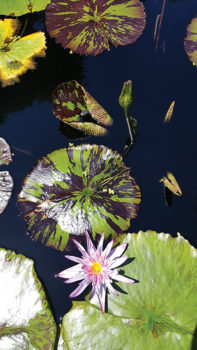
Normally, but not always, string algae is attached to something. In shallow areas of ponds with a mud or sediment bottom, string algae will grow on the bottom, where sunlight can easily penetrate. Deeper parts of the pond will not get enough light for these algae to grow. As the sunlight penetrates the water on a warm day, air bubbles containing mostly oxygen will entrain in the string algae. As these bubbles grow, the moss on the bottom is lifted to the surface and forms mats of moss. The string algae cannot maintain a hold on the sediment due to their buoyancy, and they easily become huge mats of floating moss. This explains why on hot, sunny days, many farm ponds will have a ring of floating moss around their perimeters. No question, the phosphorus that is so prevalent in fertilizers and animal waste contributes to the growth of these algae.
You may not realize it, but you may have a natural remedy that can control string algae. A client once called me about a problem with what he called a “waterlily invasion.” The variety of waterlily was Nuphar, or yellow waterlily, a native to the Midwest. His two side-by-side ponds were ringed with green leaves and yellow buttercup flowers. He wanted to kill the waterlilies, since it was tough fishing through the lily pads. I recommended that he not kill all of it, because without this plant, he would still have the moss problem thanks to the shading of the leaves. I suggested that he kill off only the area around his dock where his grandchildren liked to fish.
What about the string algae in water gardens? They can become a huge problem in shallower areas, just like in the farm ponds. However, after they attach, they stay there, growing from the bottom of the pond to the top. If there is a lot of sediment, they will float like they might in a farm pond, but if among the plants, the algae will attach themselves to the leaves. They love to grow on rocks and in streams that have a lot of light. These are normally shallow areas where sunlight can easily penetrate the water.
String algae take on different forms, depending on the water temperature and nutrients in the environment. They can become rather soft and not as stringy in the winter. New ponds generally do not see a lot of string algae during the first two years, but they almost always show up eventually. It can show up quickly if any plants, stone or other materials that you have sourced from elsewhere may have been exposed to them. To prosper, these algae need the phosphorus that is ever-present in our water and soil. Simple windblown soil can contribute to the phosphorus level. A lot of organic material has phosphorus in it, and this can also contribute to the growth of string algae.
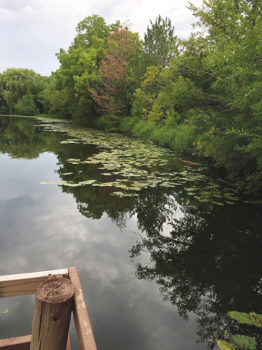
Controlling string algae can be done by a variety of methods, most of which have significant drawbacks. You can simply dye the water so that sunlight cannot penetrate the water. I prefer black, but regardless of what you choose, remember to make the water dark enough so that you cannot see your hand under a few inches of water. You will need to add dye several times during the year, since UV light degrades the dye over time. Dyeing does not control string algae in streams, as they are shallow. Some people want to see their fish in the deeper water and prefer a clear-water situation; obviously, dye will not work for them. Ecofriendly dyes are now available that are safe for pets and do not stain most rocks, depending on the stone and strength of the dye. When dye does stain a little, it dissipates quickly with UV light. From my experience, I would not worry about staining. For plant geeks, the black-dyed water makes a wonderful contrast to the green leaves along the surface.
If dye isn’t your preferred solution, try adding salt to the water. I like to add up to 3 pounds of pure salt for every 100 gallons of water. You can use water-softener salt, but only without additives. Pure salt is what you’re after. Add in increments of 1 pound per 100 gallons over the course of a week. At this level, the fish will love it, but plants will not. Most submerged and floating plants will die. Waterlilies will hang on, but they will not like it. Remember that evaporation concentrates the salt. Anytime you lose water from the pond due to a leak or a huge rain event that overflows the pond, you may need to add more salt. Remember, salt is also harmful for your terrestrial plants, so when you pump out the water during a cleanout, for example, do not pump it into the same spot in the landscape on a regular basis. As an added note, most of the salt will need to be removed before winter. Salt lowers the freezing temperature of the water. A pond can become supercooled, which will endanger your fish.
Using barley straw can control some string algae, but it depends on the species of algae. Place loose straw in a mesh bag and add it to the water as soon as ice is out, or as the water warms after winter. Use one pound of straw per about 75 square feet of pond surface area. Locate the bag under a waterfall, in a stream or at any location where there is heavy aeration. It is the decomposition of the barley straw that inhibits the growth of string algae. The placement locations should be in high-oxygen areas, where decomposition will occur easily. Repeat this as soon as you see that the straw is decomposed. This technique is very ecofriendly and will work in a lot of situations.
There are some commercial products available that work, but they can be expensive. One that I have used a lot and recommend is Pond Balance. Use it according to the directions. It’s very ecofriendly and, like barley straw, it inhibits the growth of string algae. It will not kill off a lot of growth — at least in my experience. So, use it early in the season to get a jump on it.
Surface Algae
It takes years to build up the varieties of surface algae that make up the basis of the patina of a pond. The length of time needed for this maturation process depends on water temperature and exposure to other bodies of water that could potentially inoculate a water garden. I am convinced that three to four years is the average length of time for a biofilm to come close to maturity here in the Midwest. This period, I am assuming, is shorter in warmer climates. I also have seen instances where a pond with a mature patina layer does not have string algae growth in it. The surface algae have occupied the space, so any string algae have a more difficult time establishing in that space. String algae will still grow in the stream anyway over the winter after killing the biofilm.
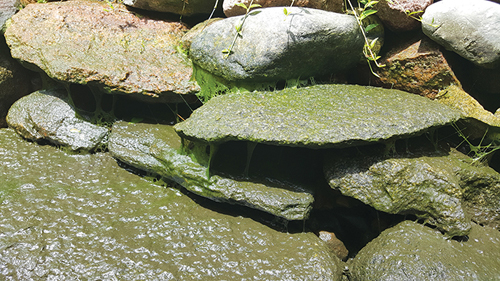
Surface algae are the blessing that we must come to appreciate. If we did not have algae and their associated invertebrates, our natural and man-made bodies of water — water gardens included — would become cesspools. Even the cursed kinds of algae provide a huge amount of natural filtration. It is only when things are out of balance that these groups become a problem. Aeration can be added to make up for the lack of algae if there is a huge fish load or a lot of organics in the system.
Using some kinds of algae killers will not only kill planktonic and string algae, but they also will kill the surface algae. The algae killers that have copper in them are extremely lethal for invertebrates, but they can also kill fish in certain concentrations. This toxicity also applies to other heavy metals. It’s true that fish can withstand a certain level of heavy metals, just as we humans can, but as they build up in a system, they become toxic. These should be used only as a last resort.
So, are algae a blessing or a curse? To most inexperienced water gardeners, a curse seems to be the obvious answer. However, if I may speak for those of us who have had the chance to think about the causes of algae problems and the solutions, I’m betting now you’re thinking that algae is a blessing. At least I hope so!


